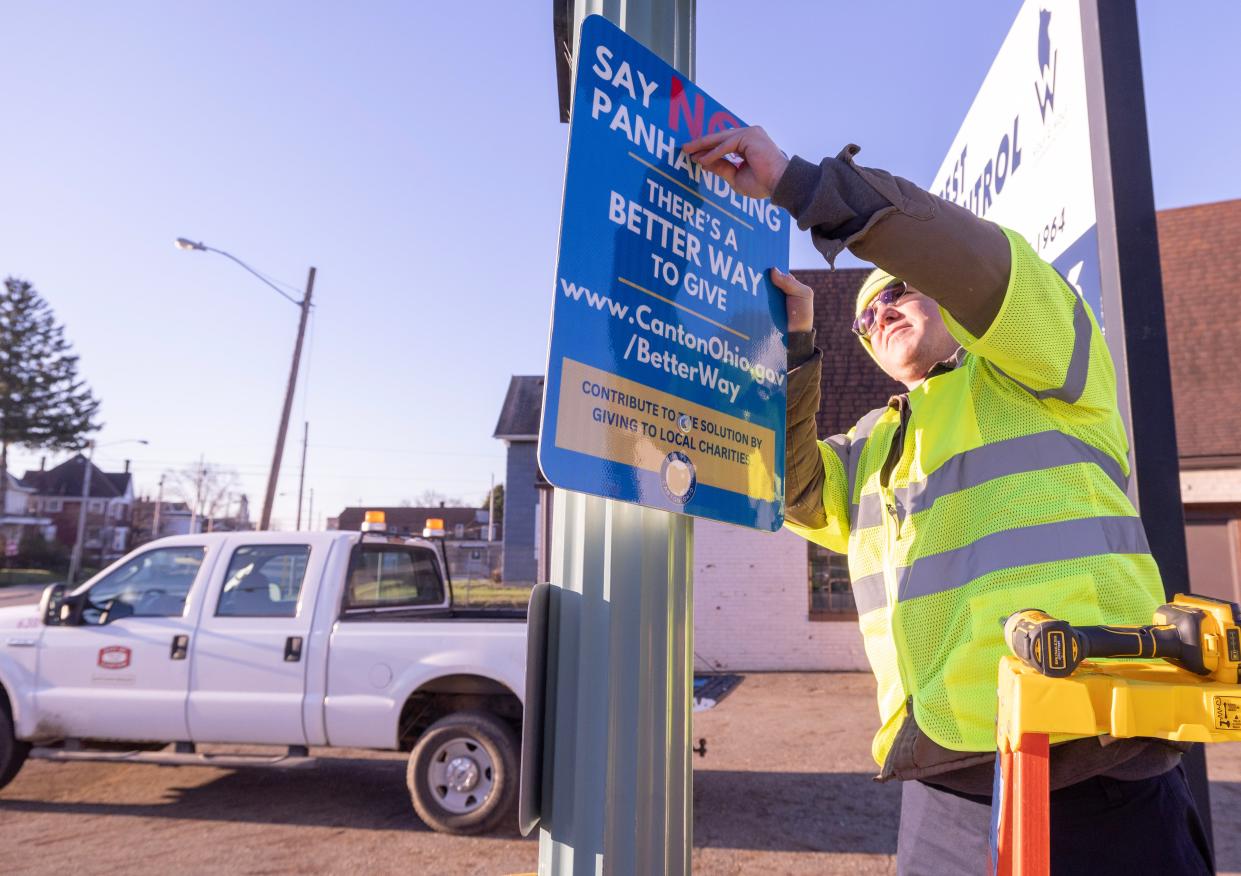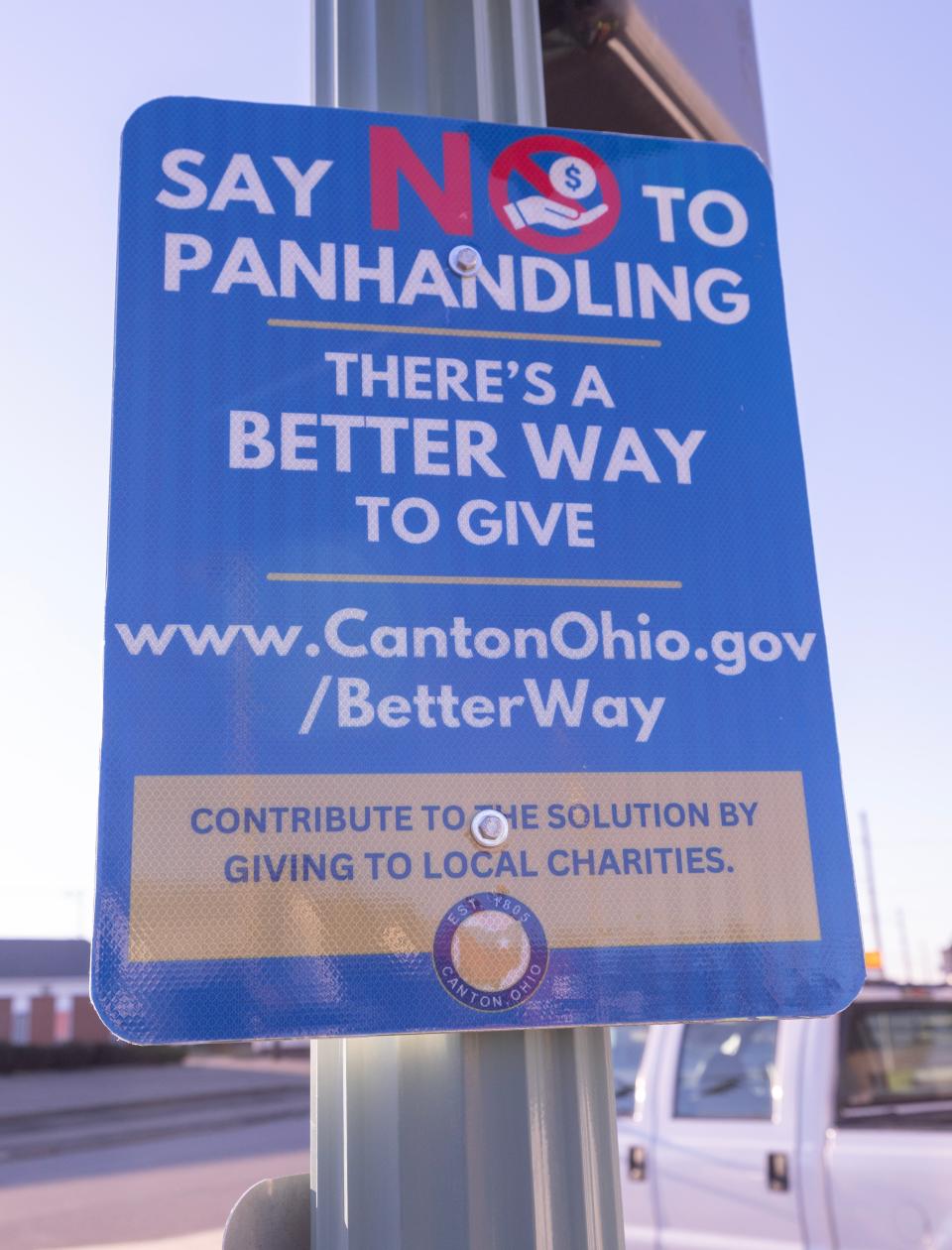Canton seeks to deter panhandling with 'Better Way to Give' initiative

CANTON – On many weekdays, a man standing at the corner of McKinley Avenue and 12th Street NW holds a cardboard sign that tells passersby to “Be Nice. It does work.”
He greets oncoming vehicles with a wave or a nod, whether they stop to give him money or not.
On Thursday, when the below-freezing temperatures likely kept him indoors, Canton city workers installed a sign at the intersection that encourages motorists to give their money to local charities rather than to panhandlers like him.
The sign reads, “Say no to panhandling. There’s a better way to give” and directs people to a city website – www.CantonOhio.gov/BetterWay – for additional information on local nonprofit organizations.
City workers are installing 37 signs across the city at intersections where people frequently ask motorists for money. The final four signs are expected to be erected today at the 12th Street NE and Market Avenue N intersection.

Here are five things to know about Canton’s new signs:
1. Canton Mayor William V. Sherer II is leading the ‘Better Way to Give’ initiative.
Sherer, who took office in January, said the signs are a low-cost way to deter panhandling in the city while also supporting local nonprofit organizations that can help address the root cause of the person’s struggles by providing meal vouchers, gas and financial help.
“We’re just trying to educate the public that there is a better way to give besides giving to the panhandlers,” said Sherer, who added that Canton City Council also supports the initiative. “There are so many nonprofits and they do a very good job in our community.”
2. Eight nonprofit organizations currently are listed.
The signs direct people to the website www.CantonOhio.gov/BetterWay where visitors can see a growing list of community agencies that help people facing homelessness, lack of food or need mental health and drug addiction services. While its a city website, the city does not receive money from the donations given to the agencies. The website also encourages people who need help to visit StarkHelpCentral.com for resources.
Kristie Woods, community relations director for Refuge of Hope Ministries, believes the signs give a helpful message to both the person standing at the corner and the passerby who may feel a tug at their heart as they wonder what happened or what they can do to help.
“Giving $20 at the corner will buy a couple meals but it won’t be long before another $20 is needed,” said Woods, who encouraged people to give panhandlers the dignity of a kind interaction. “Giving that same amount to a nonprofit like Refuge of Hope provides a week of meals, free clothing and hygiene items, shelter for men experiencing homelessness, a visit with a doctor, mental health counseling, and groceries.”
She said Refuge of Hope residents are not permitted to panhandle because the agency provides three meals a day, a place to sleep and the ability to shower and wash their clothes.
"Their needs are being met and they couldn’t get all of that for $20,” she said.
3. The signs had to be reinstalled.
The signs originally went up at the end of February but were taken down last week when city officials learned they contained an incorrect telephone number.
The original signs directed people in need to call 211, but the United Way of Greater Stark County discontinued the information hotline in January 2023 due to a lack of calls. People in need are now directed to StarkHelpCentral.com, which provides more than 700 resources related to substance use, mental health and other issues.
Canton has spent roughly $350 in materials and ink to print the signs. Mike McCroskey, a traffic sign and paint marking specialist in the city Engineering Department, said the department reused old metal signs the city has taken down over time.
4. The signs do not ban panhandling.
Panhandling is legal and giving to panhandlers is legal in Canton – and most other places nationwide.
Canton had a law that banned panhandling from 1995 until 2019 when council repealed the ordinance to avoid a potential legal challenge from the American Civil Liberties Union of Ohio.
The U.S. Supreme Court in 2015 and several federal courts since then have determined that panhandling restrictions violate the First Amendment. A state law still prohibits people from soliciting vehicles on highways, unless a charitable organization receives a permit.
Canton Law Director Jason Reese said panhandlers still could be arrested if they violate other laws such as blocking traffic. He added that because panhandling is legal, people do not need a permit to do it.
5. The signs were effective in Dublin.
The city of Dublin, a suburb of Columbus, erected similar “Say no to panhandling” signs in 2018 as part of a yearlong campaign to educate the public about the community organizations and resources available to help people in need. Besides the signs, the city created a dedicated website for the campaign and promoted the effort on social media, in its e-newsletter and with pocket-sized handouts.
Lindsay Weisenauer, director of communications and marketing for Dublin, said the campaign’s impact was immediate. She said the city received noticeably fewer public complaints about panhandling. The police department also reported a notable decrease in panhandling activity.
Even though the city discontinued the resource website and only two of the original four signs remain, panhandling complaints continue to be low, she said.
Reach Canton Repository staff writer Kelli Weir at 330-580-8339 or kelli.weir@cantonrep.com.
This article originally appeared on The Repository: Canton looks to deter panhandling with Better Way to Give signs

